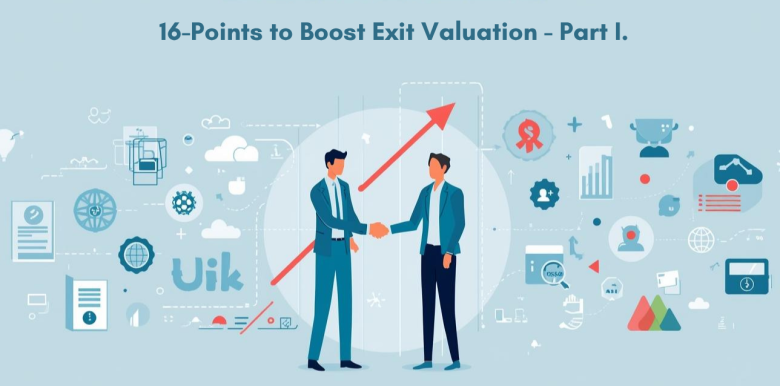16-Points to Boost your Exit Valuation (Part I)
You’ve built your firm from scratch, delivered projects across geographies, and perhaps now you’re thinking: “If I ever exit, what’s this business really worth?”
Valuation is part art, part science. But more importantly, valuation is something you can influence—if you prepare ahead. Below is a hands-on guide for Indian IT services founders, largely derived from scores of deal conversations, negotiations and closures driven by Ecosystem Ventures M&A team.
How Buyers Think: What They Care About
If you flip the conversation—and imagine yourself as the buyer acquiring your company—this is what you’d ask:
- “What are the risks and how predictable is the future revenue?”
- “If the founder leaves immediately, how much will value drop?”
- “Are there technology gaps, or client overdependence, or regulatory/legal holes?”
Valuation is less about “what you want” and more about “what a cautious but opportunity-seeking buyer is willing to pay.”
Use that lens as you read the rest below: each item is not just a “good to have” but a factor in reducing buyer risk—or increasing upside for them.
Common Valuation Methods (Quick Summary)
These are familiar, but worth revisiting to frame expectations:
| Method | When Usually Used | Pros / Cons |
| EBITDA Multiple | Most common in mid-sized service firms | Simple, widely understood. But if margin quality is shaky, buyers will heavily discount. |
| Revenue Multiple | Smaller firms, early stage, or margin volatility | Easier for buyers to relate in early deals. But limited in capturing cost discipline. |
| Discounted Cash Flow (DCF) | As a sensitivity check or for forward projections (Rarely used for smaller deals or companies) | Helps sanity-check a high multiple, but it is susceptible to assumptions. |
In the Indian IT services space, you’ll often see deals quoted in the range of 5x–12x EBITDA, depending on scale, risk profile, and niche specialization. (Note: actual deals may fall above or below based on execution and positioning.)
The 16 Key Factors that can Sweeten Your Valuation
Here are the key drivers that the buyers use to decide on how much to sweeten your exit valuation (and why).
1. Scale & Thresholds
- Crossing $10M, $25M, $50M revenue tiers opens doors to larger buyers.
- Scale reduces execution risk for acquirers.
2. Client Diversification
- If one client = 40% of your revenue, buyers worry.
- A spread across industries and geographies signals stability.
3. Strong Margins
- Efficient delivery and cost discipline show resilience.
- Buyers want to know you can weather shocks without bleeding.
4. Premium Enterprise Tech Skills
- SAP, Salesforce, cybersecurity, data engineering, AI/ML, and cloud practices often command a strategic premium.
- Why? Buyers pay extra for capabilities they can’t easily build in-house.
5. Recurring / Contractual Revenue
- Managed services, annuity contracts, multi-year SLAs = predictability.
- Reduces fear of revenue “falling off a cliff.”
6. Founder Commitment (2–3 Years)
- If you’re willing to stay for a couple of years, buyers see smoother transition.
- It lowers “founder dependency risk,” and they often pay more for that assurance.
7. Multiple Founders / Leadership Depth
- Companies led by a team (not one hero) are safer bets.
- Buyers love knowing the business won’t collapse if one person steps away.
8. Client Geography
- Acquirers pay more if a higher % of your revenue comes from US, UK, or EU markets.
- These clients are considered more stable, premium-paying, and offer stronger growth visibility.
9. Client Size
- Direct contracts with large enterprises (Fortune 500, global MNCs, Tier-1 Indian corporates) fetch higher valuations.
- Larger clients = stickier relationships, long-term revenue visibility, and upsell opportunities.
10. Industry Specialization
- Deep domain focus in BFSI, pharma, manufacturing, or healthcare creates differentiation.
- Buyers see higher margins and growth prospects when you’re not a “generic” IT services provider.
11. Partner Certifications
- Certifications like Salesforce Summit Partner, Microsoft Gold Partner, or AWS Advanced Partner status send strong signals of capability and credibility.
- Buyers value this because it indicates client trust, technical maturity, and preferred-vendor access.
12. On-Shore Team Presence
- A higher number of on-shore consultants (in the US, UK, EU) shows you can manage client relationships closely and align with time zones.
- Buyers see this as proof of stronger delivery integration and reduced client churn.
13. Pre-Built Accelerators / Products
- If you have ready-made frameworks, accelerators, or niche products, you differentiate on delivery speed, cost savings, or margin expansion.
- Buyers love IP-backed differentiation because it moves you from a pure “body shop” to a more scalable services+IP model.
14. Clean Financials & Governance
- Audited books, clear contracts, no hidden tax/regulatory issues.
- This reduces diligence “haircuts.”
15. Strong Delivery & Low Attrition
- Healthy utilization rates and low attrition = operational stability.
- Buyers want confidence that talent will stick post-deal.
16. Growth Pipeline
- Visible pipeline > past growth.
- Buyers pay for future potential if it’s backed by real contracts or credible prospects.
Use this comprehensive list to start preparing for a potential exit way in advance. And feel free to ping the Ecosystem Ventures M&A team for a free consultation on how you can optimize this exit journey for yourself.
Here is the link to Part II.


Comments are closed.